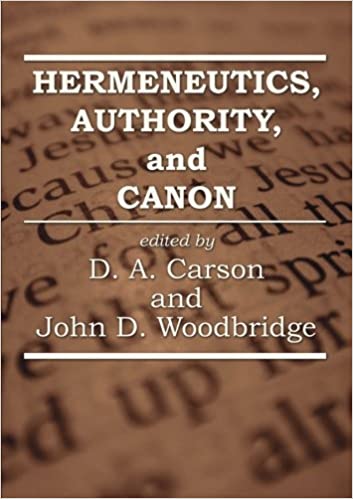A Brief Book Summary from Books At a Glance
By Benjamin J. Montoya
About the Authors
D. A. Carson, PhD, is research professor of New Testament at Trinity Evangelical Divinity School in Deerfield, Illinois.
John D. Woodbridge, PhD, is research professor of Church History and the History of Christian Thought at Trinity Evangelical Divinity School in Deerfield, Illinois.
Introduction
Hermeneutics, Authority, and Canon has become known as an important book on the various topics it covers. This book covers a very wide range of topics, as even the title itself hints at. Each of these essays merit careful attention. Although it is hard to believe that a book of this caliber is dated (15 years old now), such that a subsequent edition would have lots of other topics to cover, the insights from the book are still relevant for the various discussions had.
Table of Contents
Chapter 1 Recent Developments in the Doctrine of Scripture
Chapter 2 The Semantics of Biblical Literature: Truth and Scripture’s Diverse Literary Forms
Chapter 3 The Place of Historical Reconstruction in New Testament Criticism
Chapter 4 The Legitimacy and Limits of Harmonization
Chapter 5 The Problem of Sensus Plenior
Chapter 6 The Spirit and the Scriptures
Chapter 7 Some Misconceptions of the Impact of the “Enlightenment” on the Doctrine of Scripture
Chapter 8 The Authority of Scripture in Karl Barth
Chapter 9 The Biblical Canon
Summary
Chapter 1: Recent Developments in the Doctrine of Scripture
By D. A. Carson
There are many developments in the study of the doctrine of Scripture that could be mentioned in a chapter like this one, and this chapter makes no claim to exhaustiveness. This chapter will focus on eight issues that have arisen in connection to evangelicalism and, in a broader sense, the larger theological enterprise. This discussion is particularly focused on evangelicalism because this segment cares about the gospel and the inerrancy and infallibility of the Word of God, at least confessionally.
The first recent development is that of revisionist historiography. The second development is the focus on the phenomena of the Bible. The third development includes debates over certain key terms, like “accommodation,” “inerrancy,” etc. The fourth development involves uncritical attitudes toward literary and other tools related to literary criticism. The fifth development is sensitivity to “propositions” and “literary genre.” The sixth development is the new hermeneutic and problems of epistemology. The seventh development is the discounting of the concursive theory. The eighth development is the diminishing authority of the Scriptures in the churches. As Carson wisely notes, “A high view of Scripture is of little value to us if we do not enthusiastically embrace the Scripture’s authority. But today we multiply the means for circumventing or dissipating that authority.”
When evangelicals face these varying issues, they ought to face them with humility and courage, taking each issue seriously, but they should also continue to uphold the authority of Scripture. What these issues have forced many evangelicals to do is to take a much lesser view of the authority of Scripture, say relegating it only to certain matters, letting science and other disciplines cover other topics—as if the Bible has no relevance in those areas whatsoever.
Chapter 2: The Semantics of Biblical Literature: Truth and Scripture’s Diverse Literary Forms
By Kevin J. Vanhoozer
The title of this chapter requires some explanation. Its origin is from a book by James Barr entitled The Semantics of Biblical Literature. In this often-cited, yet rarely understood, book on the topic, James Barr insists that theologians, particularly, biblical theologians make use of modern linguistics as a way to move from the text to semantics instead of making poor use of the actual language of the Bible based on antiquated understandings of what language is and how it means. In this chapter, Vanhoozer seeks to apply Barr’s advice by considering ways to do just that.
[To continue reading this summary, please see below....]The remainder of this article is premium content. Become a member to continue reading.
Already have an account? Sign In
